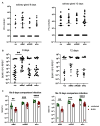Bunyamwera Virus Infection of Wolbachia-Carrying Aedes aegypti Mosquitoes Reduces Wolbachia Density
- PMID: 39205310
- PMCID: PMC11360823
- DOI: 10.3390/v16081336
Bunyamwera Virus Infection of Wolbachia-Carrying Aedes aegypti Mosquitoes Reduces Wolbachia Density
Abstract
Wolbachia symbionts introduced into Aedes mosquitoes provide a highly effective dengue virus transmission control strategy, increasingly utilised in many countries in an attempt to reduce disease burden. Whilst highly effective against dengue and other positive-sense RNA viruses, it remains unclear how effective Wolbachia is against negative-sense RNA viruses. Therefore, the effect of Wolbachia on Bunyamwera virus (BUNV) infection in Aedes aegypti was investigated using wMel and wAlbB, two strains currently used in Wolbachia releases for dengue control, as well as wAu, a strain that typically persists at a high density and is an extremely efficient blocker of positive-sense viruses. Wolbachia was found to reduce BUNV infection in vitro but not in vivo. Instead, BUNV caused significant impacts on density of all three Wolbachia strains following infection of Ae. aegypti mosquitoes. The ability of Wolbachia to successfully persist within the mosquito and block virus transmission is partially dependent on its intracellular density. However, reduction in Wolbachia density was not observed in offspring of infected mothers. This could be due in part to a lack of transovarial transmission of BUNV observed. The results highlight the importance of understanding the complex interactions between multiple arboviruses, mosquitoes and Wolbachia in natural environments, the impact this can have on maintaining protection against diseases, and the necessity for monitoring Wolbachia prevalence at release sites.
Keywords: Aedes; Bunyamwera; Wolbachia; arboviruses; mosquitoes; viruses.
Conflict of interest statement
The authors declare no conflicts of interest.
Figures






Similar articles
-
High Temperature Cycles Result in Maternal Transmission and Dengue Infection Differences Between Wolbachia Strains in Aedes aegypti.mBio. 2021 Dec 21;12(6):e0025021. doi: 10.1128/mBio.00250-21. Epub 2021 Nov 9. mBio. 2021. PMID: 34749528 Free PMC article.
-
Aedes Anphevirus: an Insect-Specific Virus Distributed Worldwide in Aedes aegypti Mosquitoes That Has Complex Interplays with Wolbachia and Dengue Virus Infection in Cells.J Virol. 2018 Aug 16;92(17):e00224-18. doi: 10.1128/JVI.00224-18. Print 2018 Sep 1. J Virol. 2018. PMID: 29950416 Free PMC article.
-
Multiple Wolbachia strains provide comparative levels of protection against dengue virus infection in Aedes aegypti.PLoS Pathog. 2020 Apr 13;16(4):e1008433. doi: 10.1371/journal.ppat.1008433. eCollection 2020 Apr. PLoS Pathog. 2020. PMID: 32282862 Free PMC article.
-
Mission Accomplished? We Need a Guide to the 'Post Release' World of Wolbachia for Aedes-borne Disease Control.Trends Parasitol. 2018 Mar;34(3):217-226. doi: 10.1016/j.pt.2017.11.011. Epub 2018 Jan 23. Trends Parasitol. 2018. PMID: 29396201 Review.
-
The Use of Wolbachia by the World Mosquito Program to Interrupt Transmission of Aedes aegypti Transmitted Viruses.Adv Exp Med Biol. 2018;1062:355-360. doi: 10.1007/978-981-10-8727-1_24. Adv Exp Med Biol. 2018. PMID: 29845544 Review.
References
-
- Moreira L.A., Iturbe-Ormaetxe I., Jeffery J.A., Lu G., Pyke A.T., Hedges L.M., Rocha B.C., Hall-Mendelin S., Day A., Riegler M., et al. A Wolbachia symbiont in Aedes aegypti limits infection with dengue, Chikungunya, and Plasmodium. Cell. 2009;139:1268–1278. doi: 10.1016/j.cell.2009.11.042. - DOI - PubMed
-
- Nazni W.A., Hoffmann A.A., NoorAfizah A., Cheong Y.L., Mancini M.V., Golding N., Kamarul G.M.R., Arif M.A.K., Thohir H., NurSyamimi H., et al. Establishment of Wolbachia Strain wAlbB in Malaysian Populations of Aedes aegypti for Dengue Control. Curr. Biol. 2019;29:4241–4248. doi: 10.1016/j.cub.2019.11.007. - DOI - PMC - PubMed
Publication types
MeSH terms
Grants and funding
LinkOut - more resources
Full Text Sources

